How Long After Shedding Will a Sand Boa Eat Again
Kenyan Sand Boas – Gongylophis colubrinus – are becoming more and more popular due to their size and temperament that are very manageable for near reptile enthusiasts.
While Kenyan Sand Boas are more often than not like shooting fish in a barrel to have intendance of compared to other snakes, there are still a number of things you should get right to keep a salubrious snake.
This Kenyan sand boa intendance sheet will make taking care of your Kenyan Sand Boa a cakewalk.
- Housing
- Juvenile Kenyan Sand Boa Enclosure
- Adult Kenyan Sand Boa Enclosure
- Substrate
- Heating
- Calorie-free
- Shelter
- Water
- Humidity
- Enclosure Maintenance
- Feeding
- Type and size of prey
- Frozen VS Live
- Feeding frequency
- Shedding
- Hibernation
- Handling your Sand Boa
- Common Issues
- Why isn't my Kenyan Sand Boa eating?
- Why is my Kenyan Sand Boa regurgitating its food?
- Are respiratory diseases normal for Kenyan Sand Boas?
- Last Words
- Sources
Housing
Getting your snake'due south housing right is one of the most important parts of proper intendance.
You demand to make sure that you provide your Kenyan Sand Boa the right kind of housing in terms of its size and environmental atmospheric condition if you desire this snake to exist happy and good for you throughout its entire life.
Juvenile Kenyan Sand Boa Enclosure
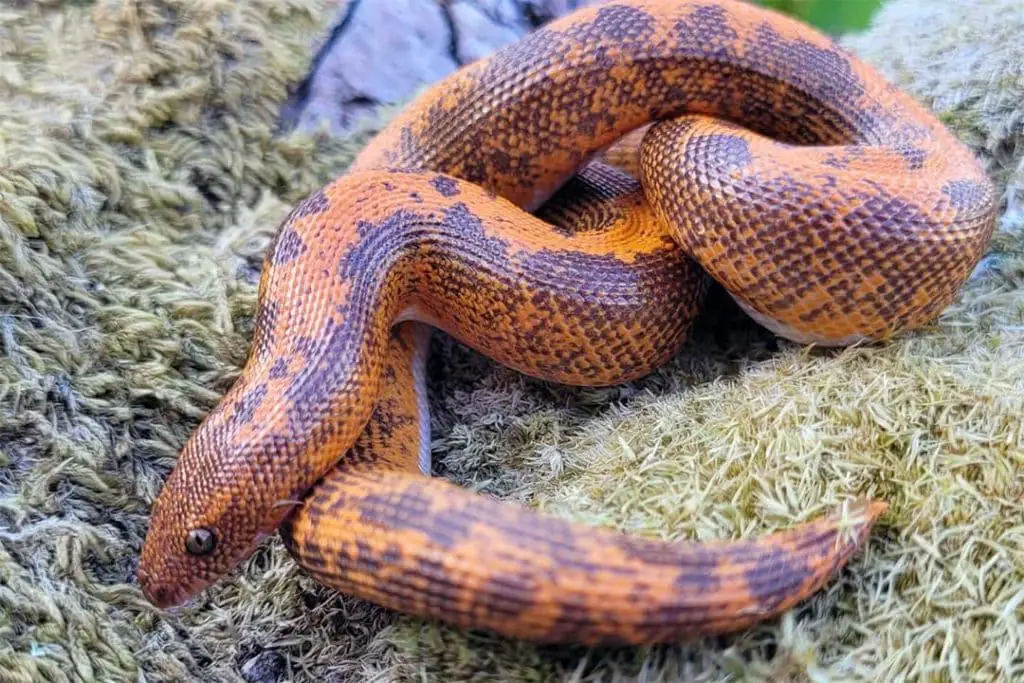
As small-scale equally the Kenyan Sand Boa is, you would be surprised how small juvenile Kenyan Sand Boas can be. At nativity, these snakes are somewhere between 6 to 10 inches as they actually are small snakes that won't demand a ton of space.
Notwithstanding, it is best to make certain that you house your babe or juvenile Eastward African sand boa in the best kind of enclosure the moment it is born or the moment you bring one home.
In well-nigh cases, it is best to house your snake in an developed-sized enclosure because of how you might want to keep them in that enclosure until it reaches machismo.
In that regard, if yous are interested in getting a skilful enclosure for a babe or juvenile Kenyan Sand Boa, y'all might want to wait into the Exo Terra Short Glass Terrarium, which I love considering of how it comes with a front-access panel that tin can let you to feed or access your snake without stressing information technology out a lot.
Exo Terra Curt Terrarium (18x18x12)
- Forepart admission will stress your animal a lot less than enclosures opening from the top
- Completely escape-proof
- Well designed ventilation
- Convenient inlets for heating cables, without any visible wires.
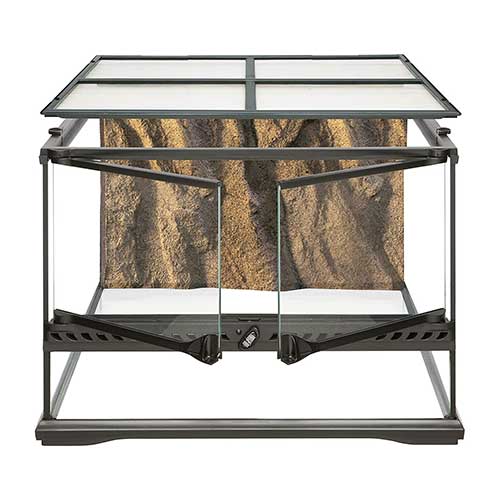
If you didn't know, near snakes tend to feel stressed when y'all try to approach them from the top because of how birds of prey tend to approach them in the wild.
Also, nosotros like this enclosure because of how it comes with special inlets for the wires of your heating pad, thermometer or thermostat.
Adult Kenyan Sand Boa Enclosure
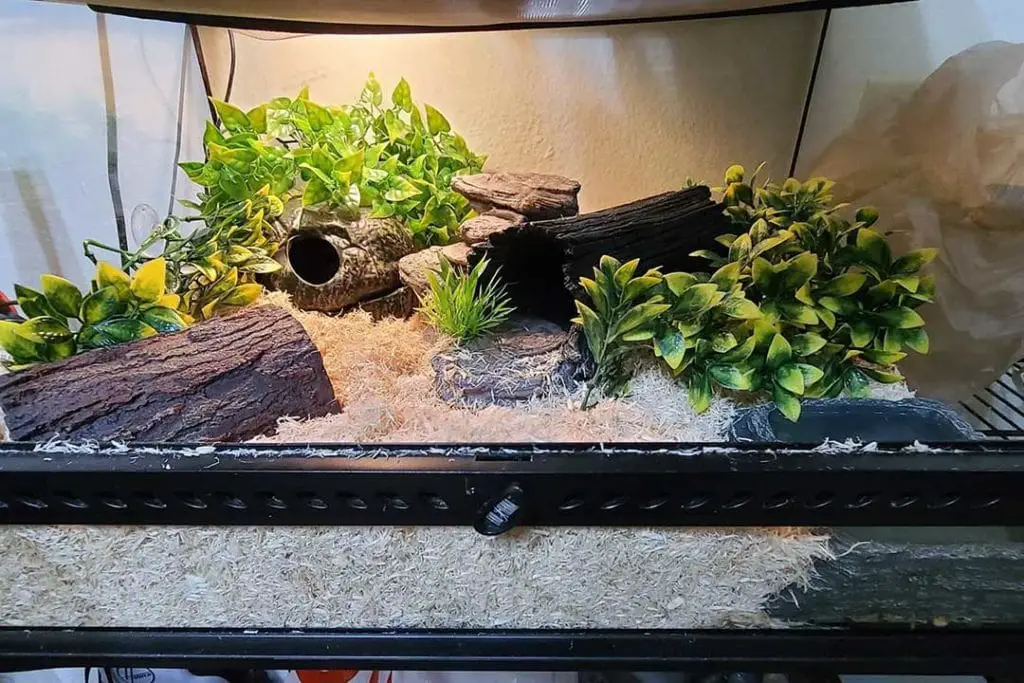
In about cases, a large tank that is about 10 gallons would already be enough for your Kenyan Sand Boa from the moment it is built-in until you take it home.
After all, the Kenyan sand boa size rarely exceeds 2 feet in length. As such, it won't hurt to house the snake in the same enclosure as long as it was already big plenty from the commencement.
However, you might want to go for something bigger if you want your snake to have more space to explore, or if you are planning on housing more than one Kenyan Sand Boa in ane single enclosure.
ReptiZoo 50 Gallons Glass Tank (36x18x18)
- Raised bottom frame for substrate heater
- Completely escape-proof
- Front access with contained doors for stress costless treatment & feeding time
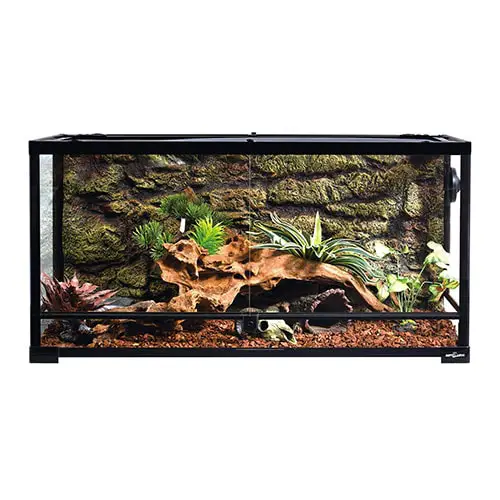
For those looking for a large housing unit of measurement for their Kenyan Sand Boa, nosotros recommend the 50 gallons REPTI ZOO Reptile Glass Terrarium. This terrarium is big enough to firm multiple Kenyan Sand Boa if needed.
However, even if you lot are only planning on housing one Kenyan Sand Boa, this terrarium should go far happy with enough space to roam around.
Of grade, we also similar this terrarium because information technology comes with practiced front-access windows, astonishing ventilation, and inlets where you can place and set up your heating elements.
Substrate
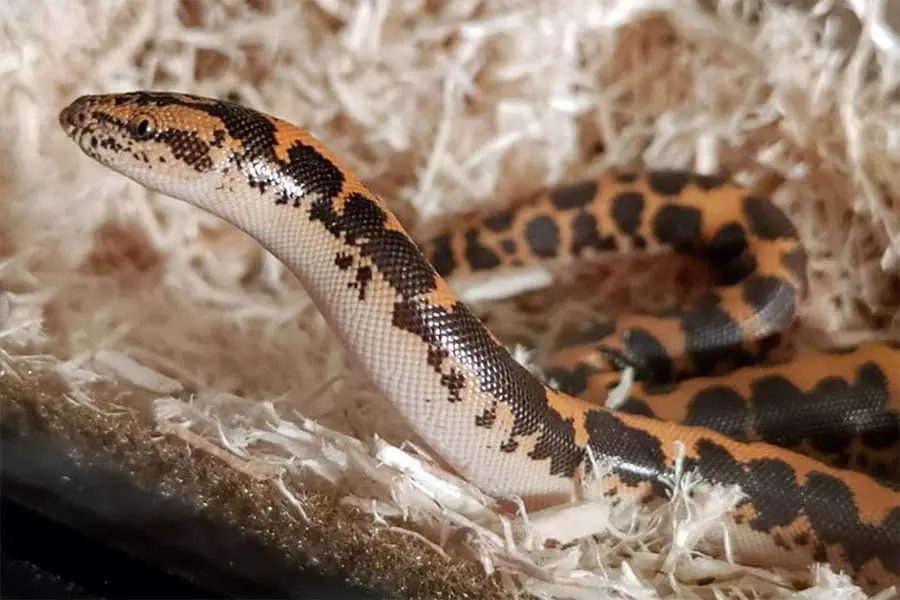
It is also important for yous to have a good substrate for your Kenyan Sand Boa, these snakes adopt to alive in environments that are every bit close to natural every bit possible.
Of course, a good substrate volition also help in regulating the humidity in the enclosure while also acting as a buffer for the heating pad under the tank, while beingness resistant to mold and parasites.
ZooMed Aspen Snake Bedding
- Easy to clean with a scooper and replace
- No dust to crusade respiratory bug
- Snakes relish burrowing in it
- Ecological product
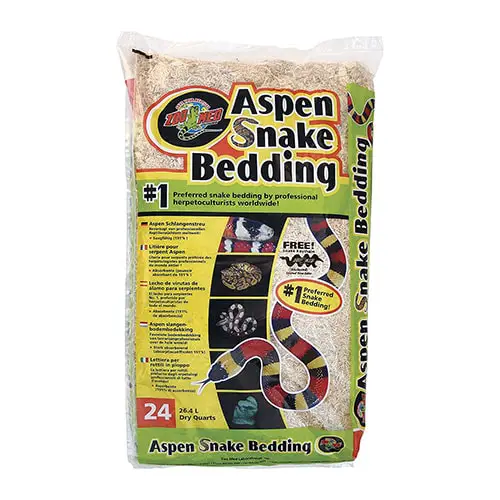
One product that I adopt when it comes to a good Kenyan Sand Boa substrate is Aspen Bedding. What we like nigh this substrate is that it comes from natural renewable resources and that it is very like shooting fish in a barrel to clean and then that you won't have whatever problem spot-cleaning it whenever you want to go along your serpent'due south enclosure spotless.
Another culling that you lot might want to look into is the ReptiChip Kokosnoot Substrate.
This substrate makes use of a thick layer of coco fries that are great at property moisture while providing a good cushioning for the Kenyan Sand Boa inside the enclosure.
Other options include reptile carpet, cork bark, cedar shavings, and coconut mulch.
Solid ground can also be an choice if you want to get the bioactive terrarium road.
Heating
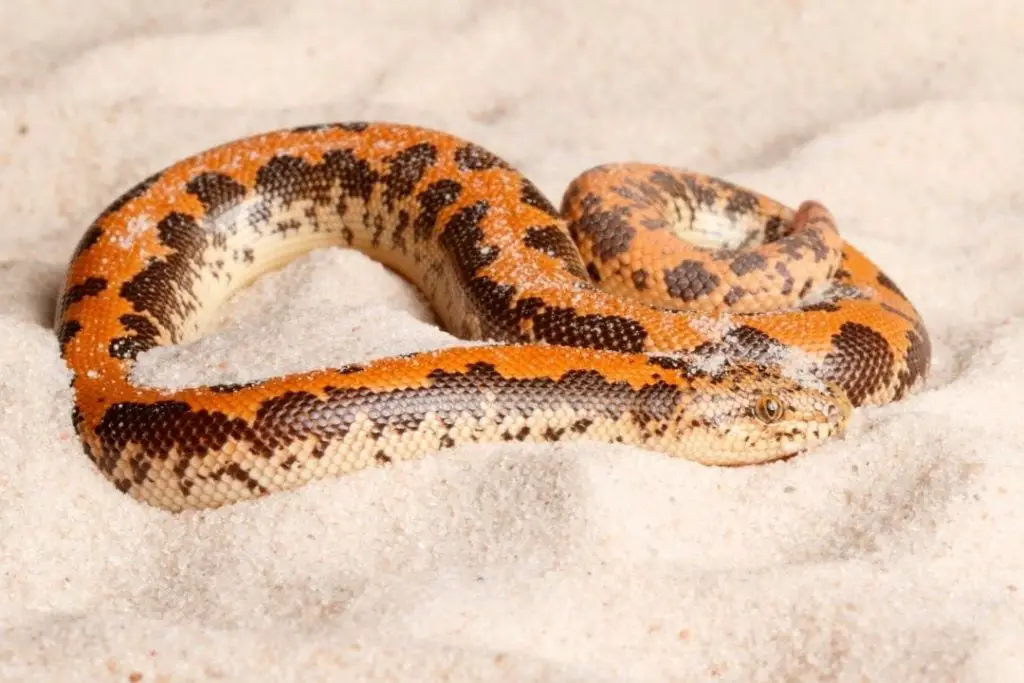
It is essential that you lot provide your Kenyan Sand Boa with enough heat, considering snakes are common cold-blooded animals that rely on external heat to regulate their body temperature.
Of form, because Kenya has a warm climate as well, giving your Kenyan Sand Boas require a warm environs that will allow them to alive in an enclosure that is every bit shut to their natural habitat as possible.
One of the essentials in a Kenyan Sand Boa's enclosure is a temperature gradient because yous want to give your snake options.
That said, yous should continue the warmer side of your Kenyan sand boa's enclosure somewhere betwixt ninety and 95 degrees Fahrenheit. Meanwhile, the libation side should non exist anything lower than 70 degrees.
I recommend that yous employ a heating mat if you lot want to provide your Kenyan Sand Boa the warmth it needs in its enclosure.
Identify the heating pad in the warmer side of the enclosure equally the excess warmth creates an ambient temperature that volition keep the cooler side somewhere close to 70 degrees:
Tikaton Reptile Heat Pad
- Only uses 8 Watts of electricity to operate
- Power adjustable so you can employ it in 10 upwardly to l gallons enclosure.
- Zero risk of called-for your serpent
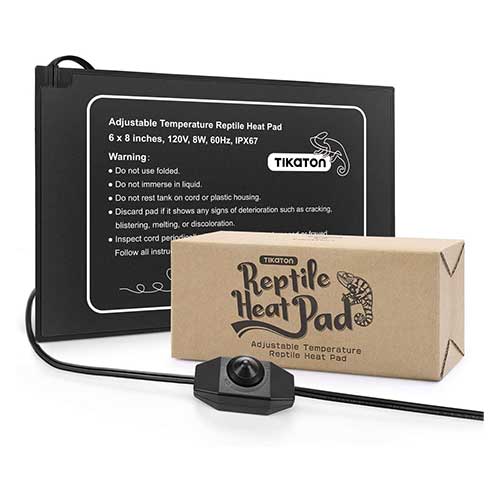
Speaking of ambient temperatures, the all-time way for you to keep track of the heat inside the enclosure is to use a thermostat.
It is recommended for yous to use a thermostat in order to brand certain that the enclosure is neither too warm nor too common cold, this will plough on and off your heat mat automatically.
Zoo Med Reptitemp Thermostat
- Built in memory stores settings in case of ability failure.
- Temperature control range: 50F to 122F
- Very reliable & easy to setup
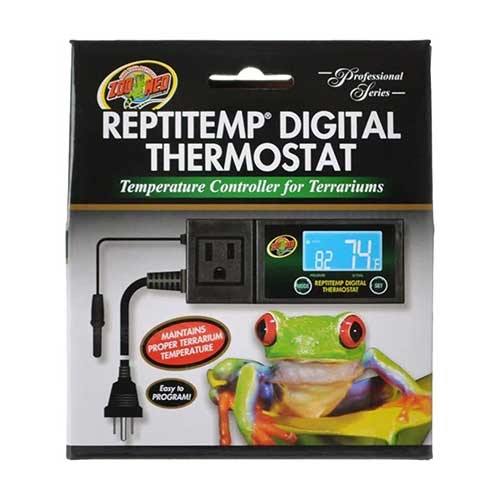
In some cases, a heat bulb may work better specially if yous live in a particularly common cold northern country or region and need to provide supplemental heat.
However, the problem with a heat bulb, or basking lamp, is that it can dry out up an enclosure or may even fire your ophidian when it is also close to the surface of the tank.
As such, it is best to brand sure that you proceed information technology a few inches from the top and avoid putting the bulb too close to the enclosure'due south surface, and that yous constantly mist the tank to keep the moisture up.
Light
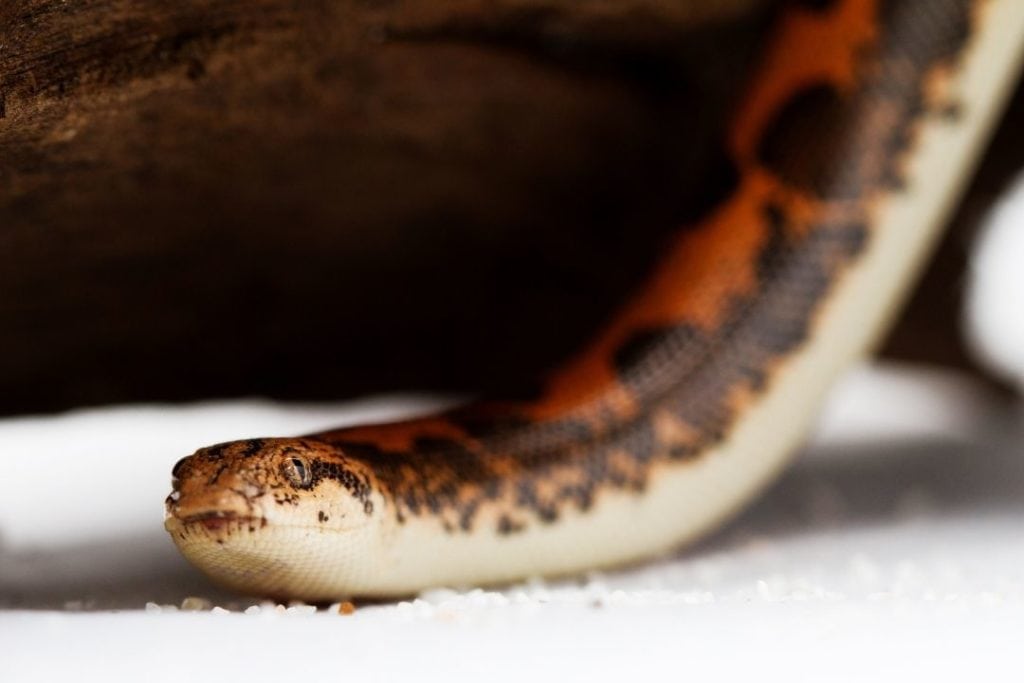
The Kenyan Sand Boa is a nocturnal snake that will spend virtually of the twenty-four hours hiding in its hide spots or under the substrate.
That's why you lot don't need to apply a UVB light for your Kenyan Sand Boa if you desire it to stay healthy because these snakes don't ordinarily apply this light in their natural habitats.
Only y'all can apply a basking lite or neon lights if you do insist on using UVB lights for your Kenyan Sand Boa's enclosure.
For those who alive in colder regions, you tin use a estrus bulb to provide the Kenyan Sand Boa'southward enclosure with heat instead of using a heating pad.
Withal, again, there are risks involved when information technology comes to these bulbs as they may end upward burning the snake or dry up the entire enclosure.
This is why I do non recommend that you use heat bulbs to provide heat and calorie-free to your Kenyan Sand Boa's enclosure.
Shelter
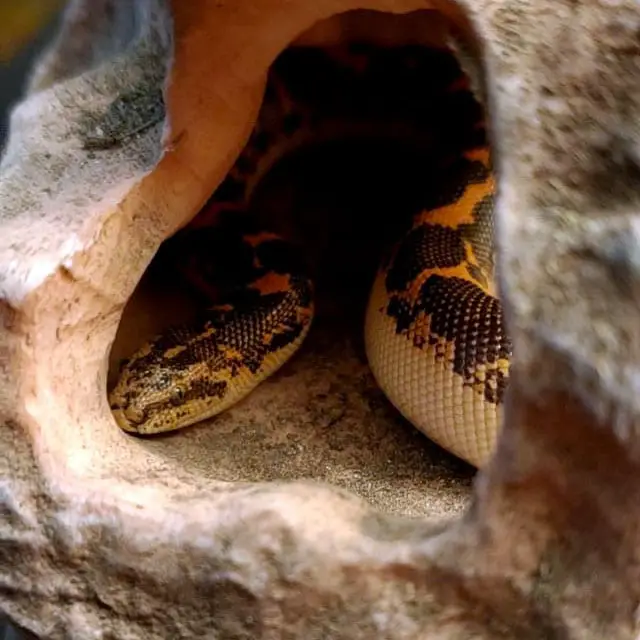
As mentioned, Kenyan Sand Boa are nocturnal snakes that tend to hide a lot during the day in their primary habitat. On top of that, these snakes have natural predators in the wild considering they are non the biggest snakes.
That said, you need to provide shelter for your Kenyan Sand Boa to make it experience condom and secure within its enclosure.
Useful decorations are of import for your Kenyan Sand Boa'southward enclosure considering you should make sure that the serpent can apply these objects as hiding spots.
Zoo Med Reptile Shelter iii in 1 Cavern, Medium
- Easy to open and clean
- Keeps humidity well for shedding
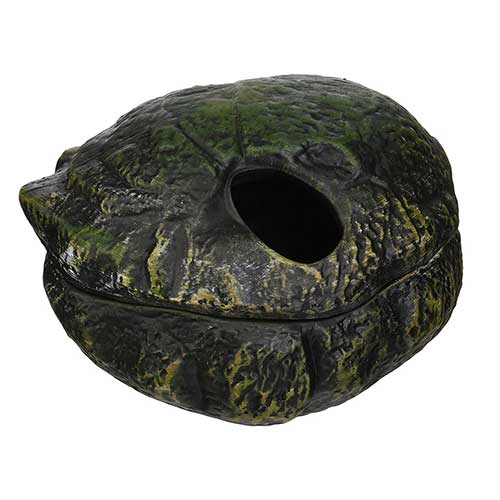
We recommend that yous use this reptile shelter for your snake considering it acts in a similar way as a cave whenever your Kenyan Sand Boa wants to stay hidden.
Nonetheless, y'all may desire to utilise large rocks or forest if you can as long every bit they are big plenty to help keep your snake hidden.
Water
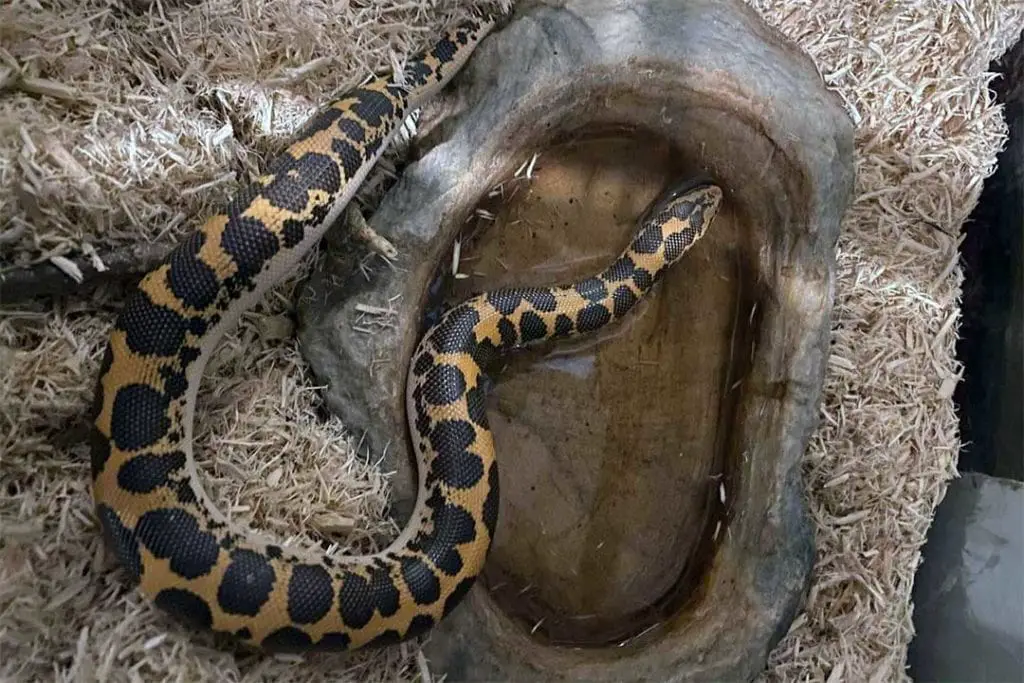
Kenyan Sand Boas are native to dry and barren environments in Kenya, only they still need to drink water from fourth dimension to time, and volition sometimes immerse themselves to help with shedding or cool downward.
You should provide a small water dish inside the snake'due south enclosure so that it will have a constant source of water whenever it wants to hydrate itself.
Repti Zoo Medium H2o Dish
- Fabricated of resin: looks good and doesn't easily tip over
- Matches well well-nigh terrarium decors
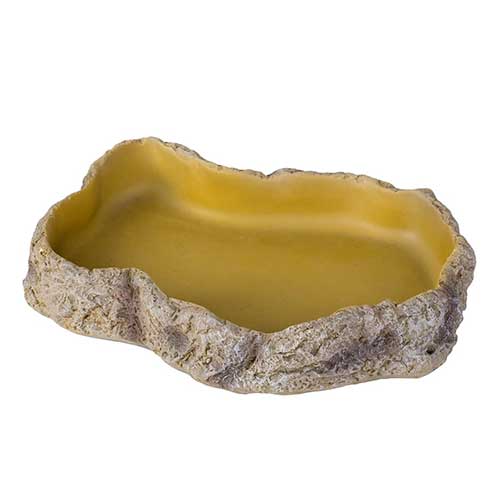
Keep the dish on the cool side of the enclosure to prevent information technology from getting too warm.
Information technology is important that you replace the Kenyan Sand Boa's water equally regularly as possible because of how you don't want bacteria and other harmful micro-organisms to build up inside the h2o.
If y'all can, replace the h2o every single day or maybe one time every two days. I would recommend that you clean or disinfect the water dish once a calendar week.
Humidity
Once again, Kenyan Sand Boas are used to dry and arid environments and are most probable going to prefer to go on themselves dry. That's why there is no need to regularly mist the enclosure unless you exercise see how dry it has go.
Continue the humidity somewhere nether 30% just permit it to go higher whenever the snake is in the eye of its shedding period because you would need to make sure the air has enough moisture to allow the snake to peel off its skin easier and pain-free.
Misting should exist your principal way of keeping the humidity constant but y'all tin can too make use of objects that are great at keeping a high humidity and property wet especially when the serpent is shedding.
Terrarium Sphagnum Moss
- Long-Lasting: Long-Fiber and Leafy Green Sphagnum Moss
- High Absorbency: Controls Tropical & Wetland Humidity
- Sustainable: Ecologically Regulated Harvests
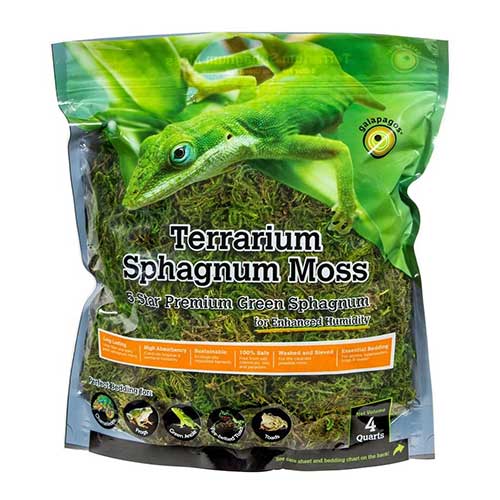
This is where sphagnum moss comes in as y'all tin identify information technology inside the snake's hiding spot so that it will be able to shed easier.
Enclosure Maintenance
Of course, it is also just as important for reptile keepers to keep their snake'due south enclosure clean if you want it to stay salubrious.
You need to clean and disinfect the enclosure as much as possible because that you don't want the snake's tank to get a breeding basis for bacteria, parasites, and other harmful organisms.
Keeping your snake'due south enclosure clean is fairly direct forrad, here are some cleaning tips that should exist helpful for yous:
- Remove the Kenyan Sand Boa from the enclosure. Just make sure that y'all have a backup tank that you lot tin can go on the ophidian in while you lot are cleaning its master tank. The backup tank should only serve equally a temporary shelter for the snake.
- Remove all of the decorations, substrate, and fixtures from the tank.
- Spot-clean the entire tank and brand sure that all of the different nooks and crannies are cleaned well plenty.
- Afterwards that, use a mild reptile-safe solution to disinfect the Kenyan Sand Boa'south tank. If yous don't take a cleaning product, use a 1:5 ratio of white vinegar and h2o to serve equally a disinfectant.
- Spray the enclosure with your solution and brand sure that you wipe information technology off using a damp towel.
- Go and get a dry towel to wipe off any of the excess moisture from the tank. Leave the tank to air dry in the open for about a day.
- When the tank is already dry, put everything back within the enclosure before your return the serpent.
- Brand sure that they have access to fresh water past irresolute the water every other mean solar day.
- It is best to do this maybe one time a month to make sure that the enclosure is as clean equally possible.
As to the substrate, we recommend that you regularly spot clean it every two days to keep any dirt or fecal thing away from the enclosure. Withal, delight do replace the substrate once every 4 months to brand sure that the Kenyan Sand Boa's surroundings is equally sanitary every bit possible.
Feeding
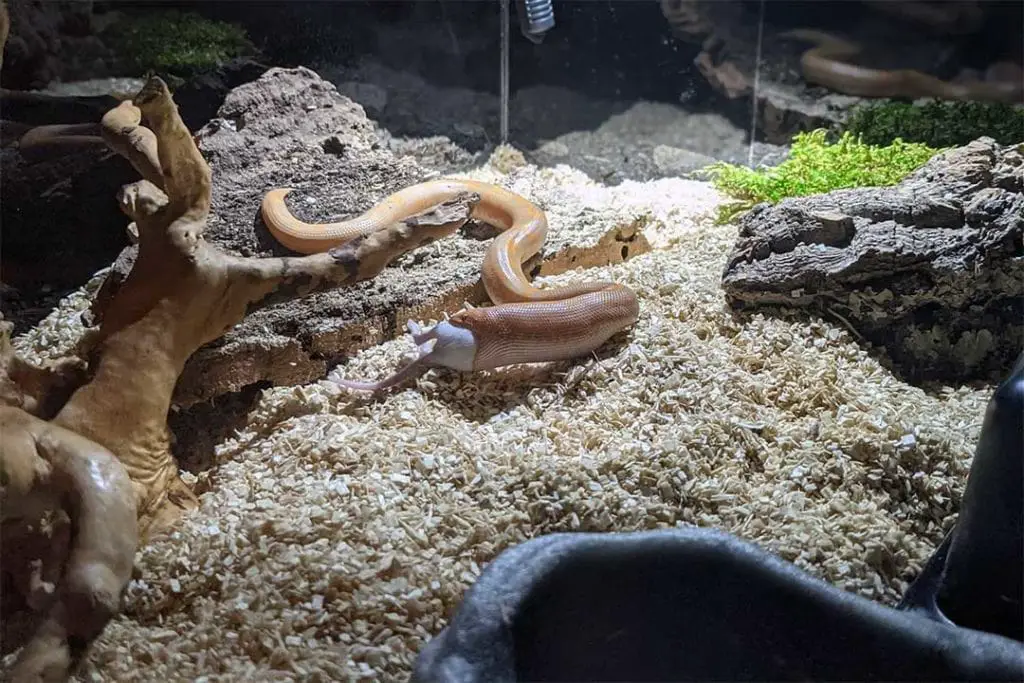
It is important to brand sure that y'all feed your Kenyan Sand Boa the right way.
And you volition be happy to know that you probably won't have a hard time feeding this snake especially considering they are not besides picky.
Type and size of prey
The Kenyan Sand Boa can really thrive well on a nutrition composed near entirely of domesticated mice and other rodents.
You can feed your Kenyan Sand Boa with mice throughout its unabridged life.
Kenyan Sand Boas that are still at the infancy stage should be somewhere around 6 inches in length. While your snake's body may be modest, they are already capable of eating pocket-sized pinky mice at this stage in their life.
Yet, it is best to make sure that your baby Kenyan Sand Boa has already gone through its commencement shedding stage earlier you feed it for the beginning time in its life.
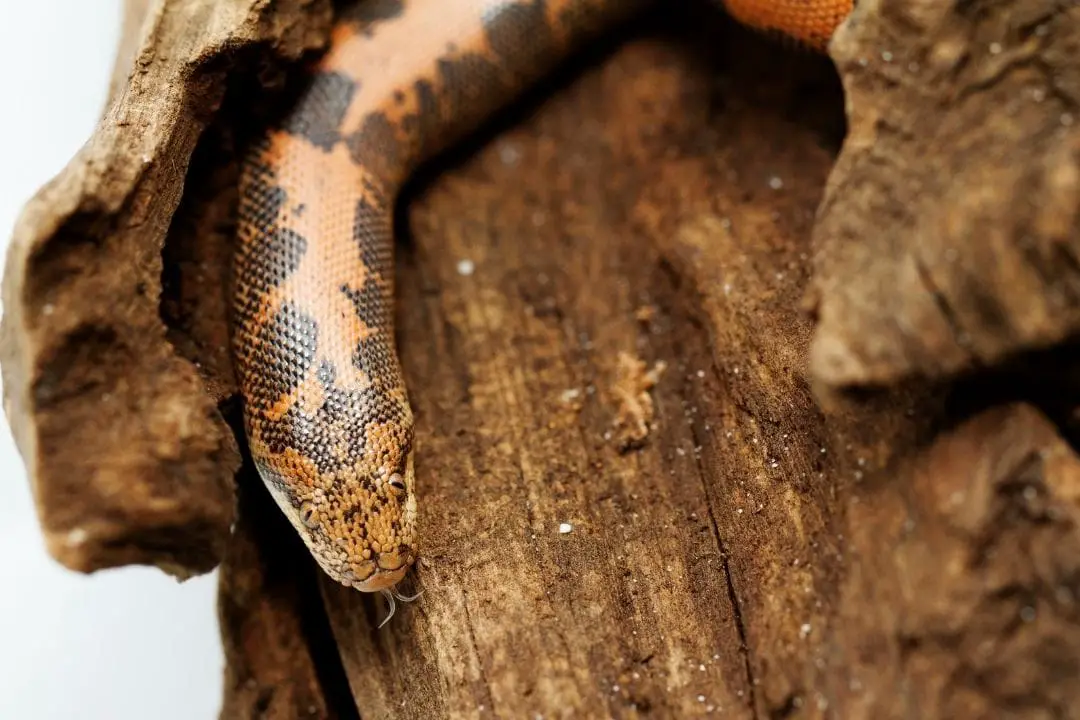
Meanwhile, the bigger the ophidian grows, the more pinky mice you should exist feeding it until it can gradually take in bigger mice such as weaned mice.
Developed Kenyan Sand Boa should exist able to exercise well on fuzzy mice or on adult domesticated mice. These snakes aren't too big and are usually somewhere close to 2 feet in length.
Adult domesticated mice are perfect for your Kenyan Sand Boa as they come at the right size for these adult snakes.
Frozen VS Live

Snakes are are much more than likely to eat live food due to their natural instinct to hunt and constrict a prey.
While there is no difference in the calories and nutrients that they intake no thing if they swallow frozen or live, picky eaters will prefer eating live rodents due to their natural hunting behaviors.
In that regard, let united states look at the arguments regarding both frozen and live nutrient.
Feeding your Kenyan Sand Boa with live food will allow you to brand sure that y'all have enough supply of food for your ophidian because you can simply keep these rodents in a separate freezer.
This reduces the storage space and try you demand for your Kenyan Sand Boa'southward food. Because frozen rodents are already dead, they won't finish upwards fighting back and injuring your ophidian when y'all feed them to your reptile.
Of form, information technology is also much more humane to go with frozen food because the rodents no longer take to get through the hurting and suffering of beingness eaten by a snake.
Only the trouble hither is that Kenyan Sand Boa tend to exist too picky when you feed them frozen rodents because they are non used to eating food that is already dead and since they would rather hunt and kill their prey earlier eating them, like their natural beliefs commands.
That means that yous would have to put in more effort so that your ophidian volition actually have its food. Poking the Kenyan Sand Boa with its food using forceps tin can be a good idea.
Micedirect Frozen Mice
- Directly from the producer
- Packed in dry out ice, delivered past FedEx
- These feeder Mice for snakes are put to slumber with Co2 and then they never suffer
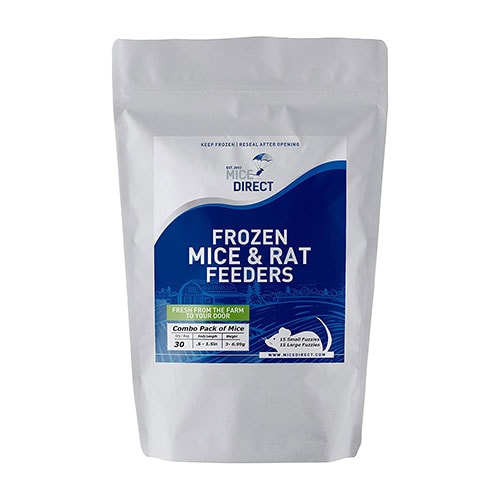
Meanwhile, you could as well argue that Kenyan Sand Boas should be better off eating live food because that is what they are used to.
However, feeding them rodents that are nevertheless alive tin can be dangerous because mice will fight back to defend themselves.
All that considered, we would like to lean towards feeding your Kenyan Sand Boa frozen food because it is much more than practical and safer for yous to do and so fifty-fifty though these snakes prefer live food more than other pet snakes practice.
But once your Kenyan Sand Boas has become used to eating frozen food, information technology won't be too difficult for you lot to feed it in the future.
Feeding frequency
Knowing when and how much to feed your Kenyan Sand Boa can get a long manner in terms of its overall health because you lot wouldn't want your snake to be malnourished or to end upward becoming overweight.
Baby Kenyan Sand Boas and younger snakes need to eat ofttimes because of how they volition need the calories for their growth. That said, feed your Kenyan Sand Boa with a pinky mouse every 4 to v days. Increase the portion sizes every bit the snake grows bigger and older. At the juvenile phase, Kenyan Sand Boa should be able to eat 2 pinky mice every 4 to 5 days.
As the Kenyan Sand Boa grows from its juvenile phase to young machismo, you may be able to increment the portion sizes a bit by feeding it with 3 pinky mice.
Make certain that you also extend the feeding schedule to maybe one time a week to forestall overfeeding your ophidian.
Meanwhile, Kenyan Sand Boas will take to swallow a full-grown domesticated mouse.
Because a male person Kenyan Sand Boa is not that large as they rarely grow over 20 inches long, you may be able to feed them once every 10 to fourteen days.
Meanwhile, bigger females should be fed more oft as they need the extra calories. Female person Kenyan Sand Boas should be fed a full-grown mouse maybe one time a week.
Shedding
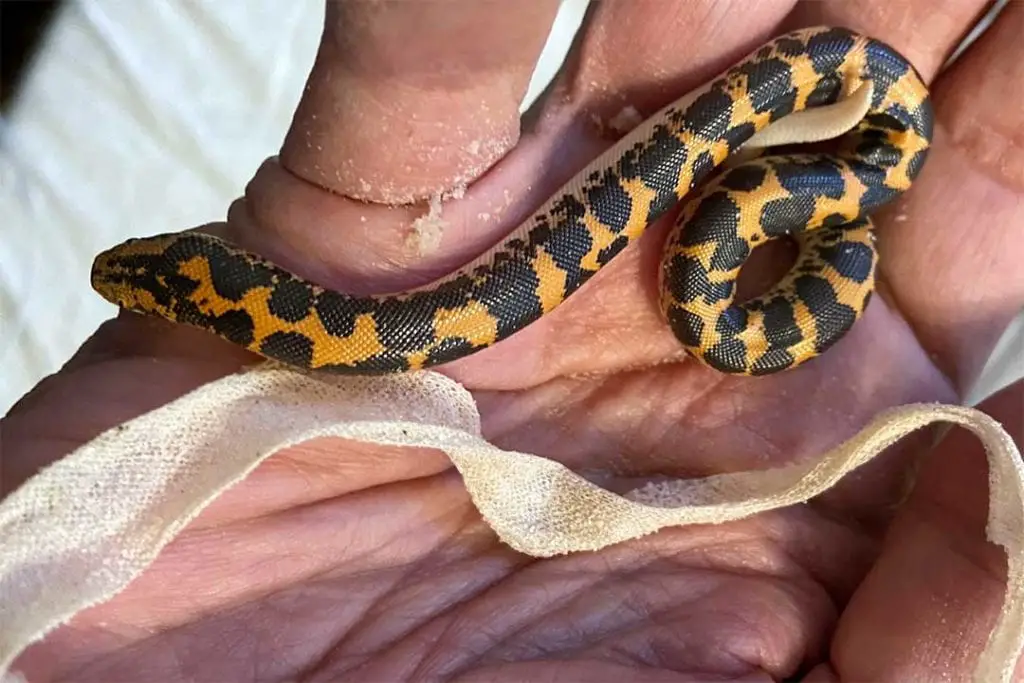
Kenyan Sand Boas volition continue to abound as they age but will have to shed their skin because their one-time skin won't grow together with their bodies.
Kenyan Sand Boas will constantly shed their peel and may end up shedding them once every iii or 4 months depending on the season and how fast the snake grows.
Make certain that you lot provide your Kenyan Sand Boa with a stress-free shed by keeping its environment a flake more boiling than it normally is.
The extra moisture in the air will allow it to shed its skin pain-free. In that case, you can mist the enclosure more than often than you usually do if you want to ameliorate the humidity inside the Kenyan Sand Boa's enclosure.
You may also provide it with a hiding box so that it tin shed without having to fear for its safety and security.
Always check the snake's enclosure whenever it is shedding because you need to remove the skin as presently equally yous can to prevent infections and other diseases brought about past the decaying skin.
Likewise, it is important that you check the ophidian'due south eyes to see if there are all the same any pieces of pare remaining.
You lot can peel the skin off yourself because it volition now be safe to handle the snake once it has removed most of its peel. It is of import to remove the skin around its optics because they can crusade infections.
Hibernation
Even though certain parts of Kenya and Africa do experience winters, we exercise not recommend that you allow your Kenyan Sand Boa to hide during the winter considering of how this can be stressful to your snake's health.
You should only allow your snake to hibernate if you desire information technology to breed afterward winter. Otherwise, do not allow it to hibernate.
It is best to brand sure that you do not allow the temperatures in its enclosure to drop too low if you don't desire your snake to end upwards hibernating during the wintertime.
However, it is alright to allow the Kenyan Sand Boa'south enclosure to drib perchance v degrees. Don't worry about decreased activity and appetite on the part of your snake during the wintertime considering of how the light wheel is reduced.
Just brand sure that it is actually nevertheless eating and that it is drinking plenty water.
Treatment your Sand Boa
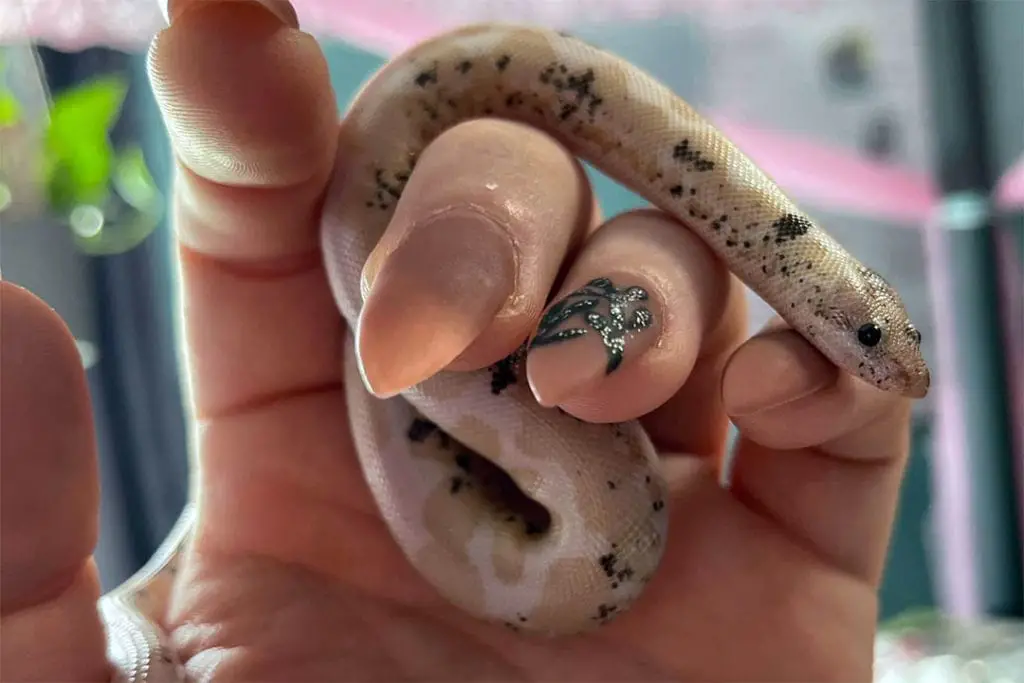
Unlike most pet snakes, Kenyan Sand Boas are non very easy to handle just they are still condom for you to handle. Most of these snakes tend to be feisty but they are still even-tempered about of the time.
That said, hither are some tips that will allow you to safely handle your Kenyan Sand Boa:
- Relax and don't come at the snake too fast considering these snakes are hands startled. Remember that the Kenyan Sand Boa'southward predators strike fast, and that is why y'all need to arroyo it slowly.
- Deport the ophidian well enough by supporting its entire weight then that it will feel secure whenever information technology is in your easily.
- Gripping the Kenyan Sand Boa as well tightly might scare information technology. That's why you need to allow it to feel free to forbid it from squirming away when it gets scared. Kenyan Sand Boas similar almost snakes tend to effort to hide or squirm away than bite whenever they are scared.
- Avoid handling the snake 2 days before and subsequently feeding it. This is when it might be a bit also grumpy.
- Don't handle the serpent whenever it is in the heart of its shedding season because they tend to be nether a lot of stress.
- Exercise not handle a pregnant Kenyan Sand Boa.
- Always wash your hands earlier treatment your Kenyan Sand Boa because you desire to go on your hands gratuitous from whatever bacteria and parasites.
Common Bug
Why isn't my Kenyan Sand Boa eating?
It tin can be common for Kenyan Sand Boas to not eat their frozen food considering they are much more than used to eating live prey. Only poke them with their food if you are feeding them frozen nutrient. Meanwhile, if your serpent is ill, such as showing signs of mouth rot, take it to the vet immediately.
Why is my Kenyan Sand Boa regurgitating its nutrient?
Your Kenyan Sand Boa will regurgitate its food if yous are feeding it likewise much. That's why information technology is necessary to brand certain that y'all are only feeding information technology the right amount of food.
Are respiratory diseases normal for Kenyan Sand Boas?
Yes, Kenyan Sand Boas can experience respiratory infections and respiratory problems from time to fourth dimension if they are living in environments that may be too common cold. Try turning the temperature up a bit if your serpent is often suffering from respiratory problems.
Last Words
Here you become! I recollect nosotros covered everything you lot need to know in this kenyan sand boa care sail.
The Kenyan Sand Boa is certainly a good serpent for beginners and novices because of how comparatively easier it is to accept care of.
Nonetheless, you may stop up with an unhealthy Kenyan Sand Boa if you don't know how to accept care of it properly.
But if you followed our care canvass and made sure to incorporate them in the mode yous take intendance of your Kenyan Sand Boa, you shouldn't have a lot of problems with your serpent's wellness and happiness.
Sources
- Cloth backdrop of the pare of the Kenyan sand boa Gongylophis colubrinus (Squamata, Boidae) – Marie-Christin G Klein, Julia Thousand Deuschle, Stanislav N Gorb
- Ecology of the Sand Boa,Eryx jayakari in Riyadh Region of Saudi Arabia – Mohammed Yard.Al-Sadoon, Fahed Due south.Al-Otaibi
- AnAge entry for Eryx colubrinus
- Gongylophis colubrinus – Wikipedia
- National Eye for Biotechnology Information – Eryx colubrinus
Bartlett and Bartlett, 2005 – R.D. Bartlett, P.P. Bartlett: Rosy, Rubber, and Sand Boas: Facts and Communication on Intendance and Breeding – Barron's Educational Series, New York (2005)
Tracer, D. P 1996. Observations on age at sexual maturity and convict reproduction in the East African Sand Boa – Gongylophis colubrinus loveridgei. Reptile & Amphibian Magazine (Feb 1996): 46-51
Pols, J.J. van der 1986. The husbandry and breeding of the Kenyan sand boa Eryx colubrinus loveridgei (Stull, 1932). Litteratura Serpentium 6 (6): 206-212
Chippaux, Jean-Philippe & Kate Jackson 2019. Snakes of Cardinal and Western Africa. Johns Hopkins University Press, 448 pp.
Source: https://reptilehow.com/kenyan-sand-boa-care-sheet/
Post a Comment for "How Long After Shedding Will a Sand Boa Eat Again"